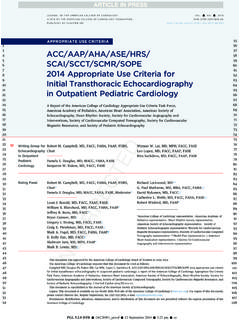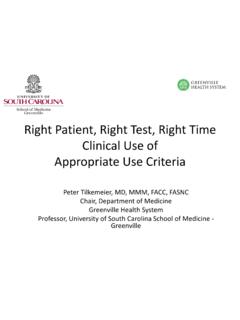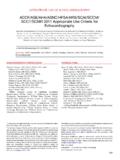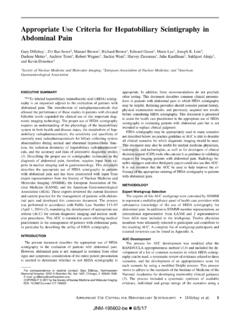Transcription of Appropriate Use Criteria
1 Appropriate Use Criteria Cervical Fusion North American Spine Society 2013 North American Spine Society Appropriate Use Criteria for Cervical Fusion This content of this document should not be construed as including all proper methods of care or excluding other acceptable methods of care reasonably directed to obtaining the same results. The ultimate judgment regarding any specific procedure or treatment is to be made by the physician and patient in light of all circumstances presented by the patient and the needs and resources particular to the locality or institution. 1 1 1 North American Spine Society Appropriate Use Criteria for Cervical Fusion This content of this document should not be construed as including all proper methods of care or excluding other acceptable methods of care reasonably directed to obtaining the same results.
2 The ultimate judgment regarding any specific procedure or treatment is to be made by the physician and patient in light of all circumstances presented by the patient and the needs and resources particular to the locality or institution. 2 2 2 Cervical Fusion Appropriate Use Criteria Work Groups Oversight Charles A. Reitman, MD, Chair Orthopedic Surgery Christopher M. Bono, MD Orthopedic Surgery Zoher Ghogawala, MD Neurosurgery Christopher P. Kauffman, MD Orthopedic Surgery William Mitchell, MD Neurosurgery Daniel K. Resnick, MD, MS Neurosurgery Alok D. Sharan, MD Orthopedic Surgery Christopher J. Standaert, MD Physical Medicine & Rehabilitation Scenario Writing Group Christopher M. Bono, MD Orthopedic Surgery Zoher Ghogawala, MD Neurosurgery Charles A. Reitman, MD Orthopedic Surgery Christopher J.
3 Standaert, MD Physical Medicine & Rehabilitation Scenario Reviewer Group Ray M. Baker, MD Pain Management & Medicine Michael H. Heggeness, MD, PhD Orthopedic Surgery Charles A. Mick, MD Orthopedic Surgery William Mitchell, MD Neurosurgery Heidi Prather, DO Physical Medicine & Rehabilitation William C. Watters, III, MD Orthopedic Surgery North American Spine Society Appropriate Use Criteria for Cervical Fusion This content of this document should not be construed as including all proper methods of care or excluding other acceptable methods of care reasonably directed to obtaining the same results. The ultimate judgment regarding any specific procedure or treatment is to be made by the physician and patient in light of all circumstances presented by the patient and the needs and resources particular to the locality or institution.
4 3 3 3 Literature Review Group Jamie Baisden, MD Neurosurgery Christopher M. Bono, MD Orthopedic Surgery Charles A. Reitman, MD Orthopedic Surgery Alok D. Sharan, MD Orthopedic Surgery Christopher J. Standaert, MD Physical Medicine & Rehabilitation William Tontz, MD Orthopedic Surgery Rater Group Paul A. Anderson, MD Orthopedic Surgery Sanford E. Emery, MD, MBA Orthopedic Surgery Christopher G. Furey, MD Orthopedic Surgery James Harrop, MD Neurosurgery Christopher P. Kauffman, MD Orthopedic Surgery Mark A. Lorenz, MD Orthopedic Surgery Raj D. Rao, MD Orthopedic Surgery K. Daniel Riew, MD Orthopedic Surgery Jerome Schofferman, MD Pain Management & Medicine Jeffrey M. Spivak, MD Orthopedic Surgery William J. Sullivan, MD Physical Medicine & Rehabilitation Jeffrey C. Wang, MD Orthopedic Surgery William C.
5 Welch, MD Neurosurgery David A. Wong, MD, MS Orthopedic Surgery North American Spine Society Appropriate Use Criteria for Cervical Fusion This content of this document should not be construed as including all proper methods of care or excluding other acceptable methods of care reasonably directed to obtaining the same results. The ultimate judgment regarding any specific procedure or treatment is to be made by the physician and patient in light of all circumstances presented by the patient and the needs and resources particular to the locality or institution. 4 4 4 Financial Statement These Appropriate use Criteria were developed and funded in their entirety by the North American Spine Society (NASS). All participating authors have disclosed potential conflicts of interest consistent with NASS disclosure policy.
6 Disclosures can be found in the document appendix. Comments Comments regarding this document may be submitted to the North American Spine Society and will be considered in development of future revisions of the work. North American Spine Society Appropriate Use Criteria for Cervical Fusion Copyright 2013 North American Spine Society 7075 Veterans Boulevard Burr Ridge, IL 60527 USA 1-929988-34-6 North American Spine Society Appropriate Use Criteria for Cervical Fusion This content of this document should not be construed as including all proper methods of care or excluding other acceptable methods of care reasonably directed to obtaining the same results. The ultimate judgment regarding any specific procedure or treatment is to be made by the physician and patient in light of all circumstances presented by the patient and the needs and resources particular to the locality or institution.
7 5 5 5 Table of Contents CERVICAL FUSION Appropriate USE Criteria WORK GROUPS .. 2 FINANCIAL STATEMENT .. 4 COMMENTS .. 4 INTRODUCTION .. 6 WHY AUCS? .. 7 OBJECTIVE .. 7 REVISION .. 8 INTENDED USERS .. 8 PATIENT POPULATION .. 8 8 DEFINITIONS .. 11 ABBREVIATIONS .. 12 ASSUMPTIONS .. 12 ORGANIZATION AND CONSIDERATIONS .. 13 OUTLINE OF SCENARIO CHAPTERS-MATRIX COMPONENTS .. 14 EXECUTIVE SUMMARY .. 16 SECTION I .. 31 SECTION II .. 33 SECTION III .. 37 SECTION IV .. 40 SECTION V .. 44 SECTION VI .. 57 SECTION VII .. 67 SECTION VIII .. 79 SECTION IX .. 80 APPENDIX .. 82 AUTHOR DISCLOSURES .. 82 LITERATURE SEARCH PARAMETERS .. 89 CLINICAL GUIDELINES SEARCH PARAMETERS .. 91 REFERENCES .. 91 EVIDENTIARY TABLES .. 94 RAW RATING SCORES .. 112 North American Spine Society Appropriate Use Criteria for Cervical Fusion This content of this document should not be construed as including all proper methods of care or excluding other acceptable methods of care reasonably directed to obtaining the same results.
8 The ultimate judgment regarding any specific procedure or treatment is to be made by the physician and patient in light of all circumstances presented by the patient and the needs and resources particular to the locality or institution. 6 6 6 INTRODUCTION With advances in research, including evaluation of clinical outcomes, evidence-based decision-making is needed for management of medical conditions. Because the volume and quality of the literature base varies across disorders, the levels of evidence are variable as well. Where there is high level evidence, recommendations are strong and easily acquired. Unfortunately, there are still numerous conditions where high level evidence is still developing or missing. This is certainly true for many spinal disorders. For those circumstances where evidence is low level or absent, it can be more difficult to determine appropriateness of treatment.
9 Although relatively new to the spine field, Appropriate Use Criteria (AUC) have been used for years in other fields as a means of determining Appropriate recommendations for medical care. Methodology has been developed and accepted to indicate reasonable recommendations for treatment. While higher level evidence is preferred, this approach allows for appropriateness Criteria to be developed regardless of the current level of evidence. In the simplest terms, AUC indicate reasonable care based on available evidence combined with a rigorous, transparent recommendation process and well-defined scenarios. AUC specify when it is Appropriate to use a They are determined through the use of clinical scenarios and consider the relative potential benefits versus harm of a AUC indicate what is reasonable to do.
10 To provide some perspective, clinical practice guidelines reflect best practices based on available evidence only and indicate what should (or should not) be done. Performance measures are based on selective, measureable interventions known to improve outcomes. These are used as quality indicators and indicate what must be done. In an AUC, an Appropriate procedure is one for which the expected benefits exceed the expected negative Regardless of established levels of evidence, spine care providers must regularly make decisions about indications for procedures. AUCs are intended to facilitate these decisions by 1 American Academy of Orthopaedic Surgeons. Appropriate Use Criteria . Available at: Accessed: 12/18/12. 2 Fitch K, Bernstein SJ, Aguilar MD et al.












